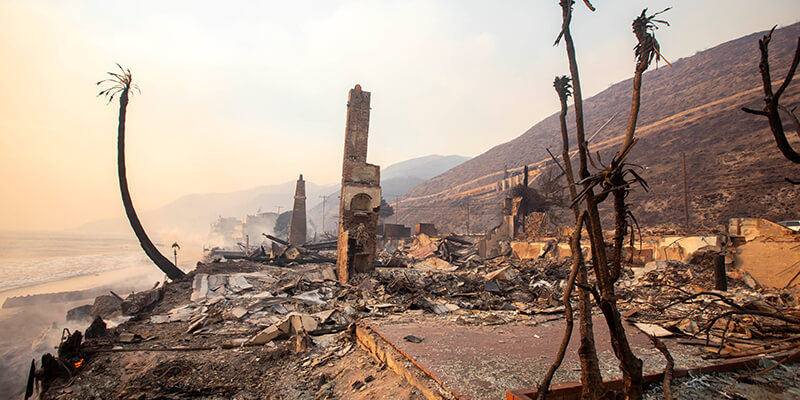Potential Impacts of the LA Fires on California’s Property Insurance Marketplace
- Written By Mitchell Paden

The devastating Palisades, Eaton, and Hughes fires could go down in history as the most economically destructive disaster, with damage estimates reaching $250 billion or higher. The results of these changes will likely have a significant impact on the way P&C insurance is written in the state of California for years to come.
Our actuarial consulting experts have been following this event closely, as have many in the insurance industry. The situation is still fluid, and the potential ramifications of the fires on the California property insurance marketplace are too numerous to touch on in just one blog. This includes one of the biggest potential ramifications: the looming threat of California FAIR Plan assessments on insurers in the state for the first time since 1994 (stay tuned for an upcoming blog on that very topic!).
For now, we are focusing our thoughts on how the aftermath of the fires may converge with recent changes enacted by the California Department of Insurance regarding rate filings.
Wildfire Models Step into the Spotlight
The ink is barely dry on the recent rule changes allowing wildfire models to be used in California property rate filings. Though the implementation of the new rules has not even occurred yet (the California Department of Insurance website estimates they will be included in updated rate filing instructions at some point during the first quarter of 2025), companies are already beginning to strategize on the best path forward for achieving adequate rates.
Ironically, California did not formally approve the use of wildfire models until December 2024, mere weeks before the Los Angeles fires broke out. Prior to this, insurance companies could not use any models regarding potential wildfire losses in their rate filings. Instead, companies were required to show at least twenty years of catastrophe loss experience, that combined wildfire losses with many other catastrophe perils (e.g., severe storms), to support their catastrophe load without the ability to place more emphasis on recent years.
As wildfires in the state have grown in both frequency and intensity, scenarios based on loss experience for the previous two decades often underestimate the current risk. As such, companies have often felt this prevented them from filing what they viewed to be adequate rates. This is one of a variety of reasons so many carriers ceased writing new business in the state.
The new wildfire model rules formally approved in December give companies an option to help bridge the gap between historical ratios and present risk by allowing wildfire catastrophe models to be used in rate filings.
The use of these wildfire models does come with conditions, though. It requires companies to write additional business in the wildfire-prone areas that many carriers ceased writing and are currently being served by California’s FAIR Plan. Though some feel that the requirement to write more wildfire-prone exposure will keep companies from utilizing the models, the ability to file for a rate level more closely aligned with present day wildfire risk may outweigh the risks that come with the increased wildfire exposure for some companies.
Our team of actuarial consulting experts see a few different reasons that some may choose to take this route and accept the conditional requirements for wildfire model use in pursuit of adequate rates.
- Rate Filing Data Evaluation Rules: California requires that the evaluation date of data in a filing be a traditional quarter-end (March 31, June 30, September 30, and December 31). Since the Los Angeles fires started the second week of the new year, insurance companies are unable to submit filings – or even begin assembling filings – that include these fire losses until at least April. Use of wildfire models would allow companies to replace all actual wildfire losses with modeled data that could be available sooner and provide a quicker path to submission.
- Inclusion of Complete Wildfire Risk: As mentioned earlier, the use of the previously required historical ratios led to catastrophe provisions that were often understated relative to today’s catastrophe risk. The use of wildfire models would allow companies to do a filing now that can support a rate that recognizes a more complete picture of a company’s wildfire risk rather than waiting multiple years for the recent increased fire activity to gain more weight in the historical catastrophe ratios.
- Subrogation Uncertainty: There have been multiple lawsuits filed claiming that the Eaton fire in Altadena, CA, was ignited by electrical equipment operated by Edison International and Southern California Edison. Under state law, utility companies, rather than insurance companies, are liable for damages if their equipment starts a wildfire. So, if Edison loses these lawsuits, much of the loss from that fire will need to be included net of subrogation recoveries from the utility company (or proceeds from the sale of subrogation rights). The same could be true for the other fires as the investigations continue into how they started. Wildfire models measure prospective risk rather than prior liability, allowing them to be used without having to potentially wait for legal liability to be determined (though the Department may want to make sure that all models have been adjusted to reflect company exposure after these recent fires).
Our expert actuaries are already fielding calls from insurance companies interested in shifting to wildfire model-based loss scenarios in their rate filings. In addition, wildfire model vendors are submitting models to the state as part of the Department’s Pre-application Required Information Determination (“PRID”) Procedure. Models that are approved via this process will help streamline the rate filing review since the model itself will already have been approved by California regulators.
For companies that are looking to get a head-start on a rate filing that utilizes wildfire models, we recommend conducting vendor research and selecting one of these approved models so that when California does formalize the instructions for submissions, companies will have modeled losses that can be quickly included in a rate filing and help expedite that filing’s review from the Department.
Net Cost of Reinsurance in Rate Filings Looms Large
Just days before 2025, California also approved new rules that allow for companies to include the net cost of reinsurance in rate filings for the first time. An industry average net cost of reinsurance could be calculated and included alongside other expenses allowable under Proposition 103.
Like wildfire models, use of the net cost of reinsurance comes with conditions in the form of increased writings in wildfire-prone areas. The increased exposure would also likely lead to increased reinsurance costs in proportion to the new risk and result in playing catch-up in times of rising reinsurance costs, which the fires will likely cause. This would be exacerbated if the industry average is not enough to fully represent company costs being paid for reinsurance.
The proposed rules do include an alternative approach that would allow companies to use their own reinsurance terms in the net cost of reinsurance calculations, but doing so would require the public disclosure of their reinsurance contracts, a condition that most companies feel they are not willing to meet.
Though there is no guarantee that the industry average will be enough to support each individual company, and there are many questions still to be answered on how it may impact proposed rates, including the net cost of reinsurance in a filing could help bridge the gap stemming from currently having no reinsurance consideration at all. The Department’s timeline estimates that the net cost of reinsurance will not be included in the rate filing instructions until the second quarter of 2025, so companies looking to maximize the tools available to file more adequate rates may wait until then to file rates using both the net cost of reinsurance and the wildfire models that upon which company reinsurance rates are often based.
The Importance of a Complete Rate Application
With so many significant changes to the allowable support in a rate filing, it is easy to forget that California also updated the rules about what constitutes a “complete” rate application. These new rules have been implemented into the rate filing instructions, so any company looking to move quickly in the aftermath of the fires should make sure that the filing package is as complete, accurate, and reconciled as possible. Public notice of filings will not take place until the state deems the application complete, so it is crucial that insurance companies carefully review all supporting documentation and model scenarios before submitting their filing to the state. Failure to do so will cause a delayed public notice date and a longer review of the submission.
The best way to speed along the process for everyone is to make the regulator’s job easier by ensuring that forms and supporting documentation are complete and ready to go, something that Perr&Knight routinely works together with the state to help achieve.





